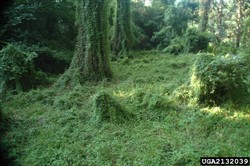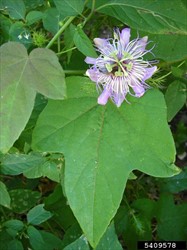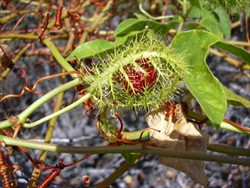Wild passionfruit. It is also known as red fruit passion flower, stinking passion flower, love-in-a-mist, goat-scented passionflower.
Pacific Pests, Pathogens, Weeds & Pesticides - Online edition
Pacific Pests, Pathogens, Weeds & Pesticides
Wild passionfruit (553)
Passiflora foetida. It is a member of the Passifloraceae.
Asia, Africa, North, South and Central America, the Caribbean, Oceania. It is recorded from Australia, American Samoa, Cook Islands, Federated States of Micronesia. Fiji, French Polynesia, Guam, New Caledonia, New Zealand, Niue, Papua New Guinea. Samoa, Solomon Islands, Tonga, Vanuatu, Wallis and Futuna. It is native to South America.
An aggressive, perennial, fast-growing vine of the tropics and subtropics covered in soft, sometimes sticky hairs, with an unpleasant smell. It invades natural environments: forest edges, coastal vegetation, banks of rivers and creeks, and seashores (Photo 1). It is also a weed of disturbed sites, fences, roadsides, wastelands, crops, and pastures, forming a dense ground cover (Photo 2). Growth is best when the plant is supported, but where support is unavailable it develops as a thick ground cover. A weed that favours tropical regions and tolerates many soil types and a range of rainfall conditions (under drier conditions more likely to be an annual). It is found from lowlands to 500 masl.
Stems, angular, 1.5 to 6 m long, branched, with glandular hairs bearing strong-smelling liquid at the tips. Leaves, on 4-5 cm leaf stalks, heart-shaped to 3-5 pointed lobes, 5-10 cm long and the same wide, alternate along the stems, with long-stalked glands and long fine hairs on margins, producing disagreeable smell when crushed (Photos 3&4). Long coiled tendrils develop from the leaf axils (Photos 4&5). Flowers from leaf axils, singular on 3-7 cm stalks, bisexual, purple and white, 4-5 cm across, surrounded by leaf-like structures (bracts), extremely divided (prickly and hair-like) (Photos 4&5). Each flower with five leaf-like sepals, five petals, two rows of purplish filaments, five stamens (male parts) and three styles (female parts) (Photos 3&5). Fruits, oval, 2-3 cm long, smooth, green at first then yellow, or orange to red (Photos 6&7). Seeds black, wedged shape.
Seeds are spread by birds and bats. Long distance spread has been via the intentional introduction of the plants as an ornamental, and to a lesser extent for food and medicinal use.
There are direct and indirect impacts. Wild passionflower has been recorded as a serious weed of maize and rubber in Malaysia, of maize, sugarcane and cotton in Thailand, of oil palm and rubber in Indonesia, and of taro in Samoa.
Wild passionfruit is an alternate host of diseases affecting cultivated passionfruit, the most common being Passionfruit woodiness potyvirus (see Fact Sheet no. 156). It is said to be poisonous for goats and humans when eaten (see under Uses).
The unripe fruits contain cyanogenic glucosides, compounds that in the human body (and perhaps other animals) can be converted by enzyme action into hydrogen cyanide, which is poisonous.
The weed is grown as an ornamental, the leaves, fruit, and the soft part around the seed (aril) are eaten, and it is used medicinally. Agronomically, the weed is used as a ground cover in coconut plantations in the Philippines, although it is difficult to control. There are several medicinal uses, e.g., for intestinal 'worms', colds and coughs, tuberculosis, snake bites, and insomnia.
BIOSECURITY
The risk of further introductions of wild passionfruit is high. It is used as an ornamental, a medicinal plant and, in some countries, parts are eaten. For those countries where the plant has not been introduced, they might wish to consider the potential weediness of the species and apply quarantine measures accordingly. Seeds are available for sale on the Internet.
BIOLOGICAL CONTROL
Waterhouse states: "Little is known about natural controls of P. foetida and no attempts have been made at biological control".
CULTURAL CONTROL
Physical & Mechanical:
- Hand-pulling isolated plants or small infestations is possible, but labour intensive. Hoeing between crop rows is also a possibility. Apply control measures before plants set seeds.
CHEMICAL CONTROL
In Queensland, Australia, no herbicide products are specifically registered for the control of wild passionfruit, but people generally are allowed to use the following for the control of wild passionfruit as an environmental weed in various non-agricultural situations under a permit issued to the Department of Agriculture & Fisheries: (i) glyphosate; and (ii) triclopyr + picloram.
- Cut stump/paint: (glyphosate or triclopyr + picloram). On mature plants, cut stems just above ground and brush or spray them immediately.
- Basal bark spray: (triclopyr + picloram)
- Best for stems of 15 cm diameter or less at breast height, using systemic herbicides carried in oil (or water-soluble herbicides labeled for basal bark application) to penetrate the thin bark at the stem base.
- Clear the stem base of weeds/debris before painting or spraying the stem base (bottom 30-40 cm) with a single coat of herbicide, avoiding run-off. If spraying, start 30 cm above soil level and spray downwards, repeating this top-down spraying all parts of the stem base. Monitor and repeat if required.
- Foliar spray: (triclopyr + picloram). On young plants, use diluted following manufacturers' instructions. Read the label.
--------------------
Note, EU approval to use glyphosate ended in December 2022, but has been extended by one year to 15 December 2023.
____________________
When using a pesticide, always wear protective clothing and follow the instructions on the product label, such as dosage, timing of application, and pre-harvest interval. Recommendations will vary with the crop and system of cultivation. Expert advice on the most appropriate herbicides to use should always be sought from local agricultural authorities.
AUTHOR Konrad Englberger & Grahame Jackson
Information from Stinking passion flower (2022) Business Queensland. Queensland Government. (https://www.business.qld.gov.au/industries/farms-fishing-forestry/agriculture/biosecurity/plants/invasive/other/stinking-passion-flower); and Stinking passion flower Passiflora foetida (2020) The State of Queensland, Department of Agriculture and Fisheries. Queensland Government. (https://www.daf.qld.gov.au/__data/assets/pdf_file/0017/55322/stinking-passion-flower.pdf); and Fern K (2022) Passiflora foetida L. Passifloraceae. Tropical Plants Database. (https://tropical.theferns.info/viewtropical.php?id=Passiflora+foetida); and CABI (2019 Passiflora foetida (red passion flower). Crop Protection Compendium. (https://www.cabidigitallibrary.org/doi/10.1079/cabicompendium.38800); and Passiflora foetida L., Passifloraceae (2011) Pacific Island Ecosystems at Risk (PIER). (http://hear.its.hawaii.edu/Pier/species/luffa_aegyptiaca.htm); and from Waterhouse DF (1994) Biological of weeds: Southeast Asian Prospects. ACIAR Monograph No. 26. 302pp. Photo 1 Forrest & Kim Starr, Starr Environmental. (http://www.starrenvironmental.com/images/image/?q=24442312880). Photo 2 David J. Moorhead, University of Georgia, Bugwood.org. Photo 3 Forest & Kim Starr, Starr Environmental. (http://www.starrenvironmental.com/images/image/?q=24643465951). Photo 4 Forrest & Kim Starr, Starr Environmental. (http://www.starrenvironmental.com/images/image/?q=24529140802). Photo 7 Forrest & Kim Starr, Starr Environmental. (http://www.starrenvironmental.com/images/image/?q=24555294021).
Produced with support from the Australian Centre for International Agricultural Research under project HORT/2016/185: Responding to emerging pest and disease threats to horticulture in the Pacific islands, implemented by the University of Queensland and the Secretariat of the Pacific.










